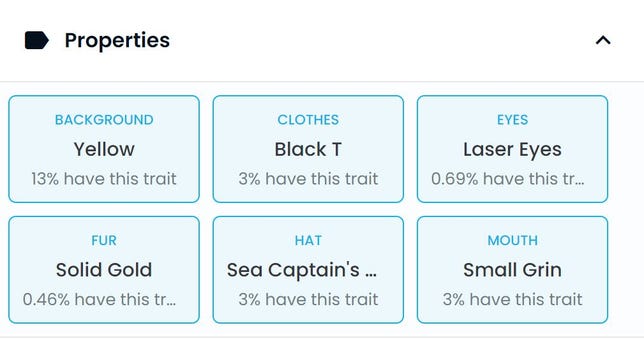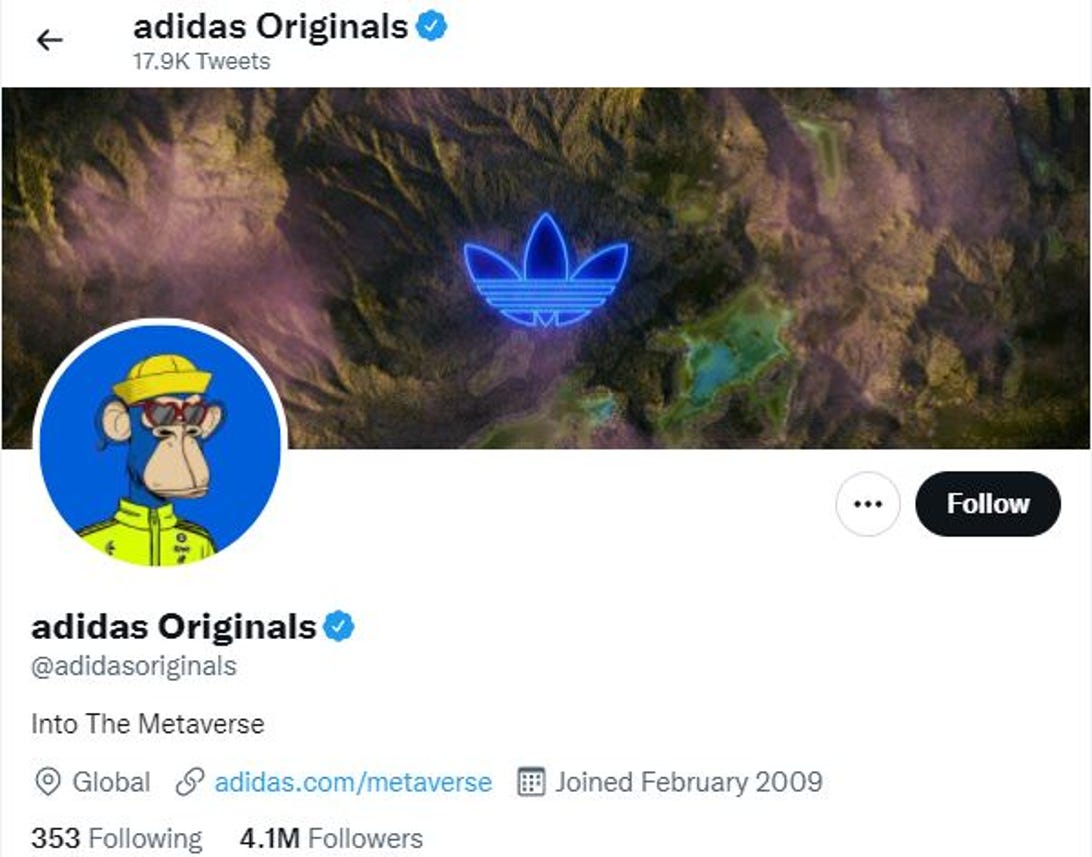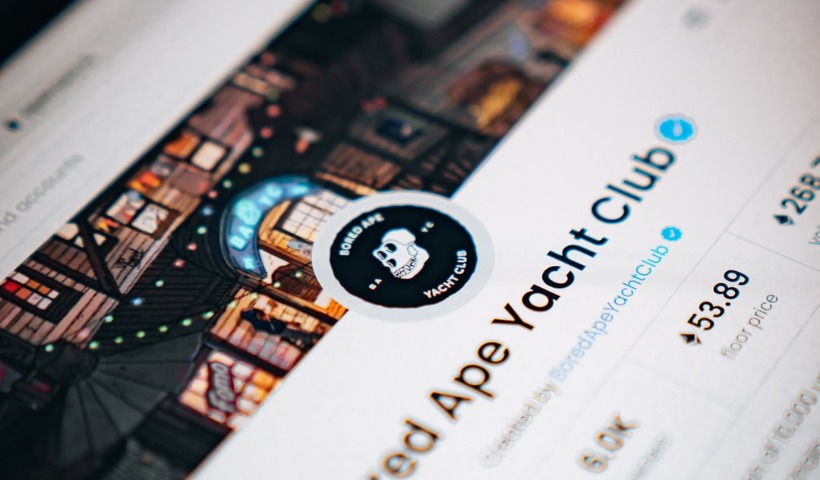NFTs are a big business, with about $25 billion being spent on them in 2021. But despite all that money flying about, nonfungible tokens have yet to enter mainstream culture. Tens of millions have heard about NFTs, but only a fraction could describe what they actually are — much less name any. Yet if there’s one brand that’s transcended NFT culture, even in minor ways, it’s the Bored Ape Yacht Club.
You’ve probably seen one, even if you didn’t realize you were looking at a pricey NFT.
Bored Ape owners currently using their NFT as a Twiter profile picture include Timbaland (1.6 million followers), Eminem (22.6 million followers) and footballer Neyman Jr. (55 million followers). Jimmy Fallon and Paris Hilton are also BAYC holders, discussing their Apes in a (cringey) Tonight Show segment. Justin Bieber made headlines with his purchase of a $1.29 million Bored Ape Yacht Club NFT in February.
Since launching last April for $200 (0.08 ether) each, the cost has skyrocketed: The cheapest you’ll find a Bored Ape NFT on OpenSea, the biggest marketplace for such wares, is $420,000 (145 ether). That ridiculous rise led to the NFTs being used as status symbols, first in the NFT space and then among celebrities too.
Yuga Labs, the company behind the NFT collection, has already expanded the ecosystem to include a cryptocurrency (Ape Coin) and is developing a metaverse (Otherside). Beyond that, people holding Bored Ape NFTs are betting that the brand will completely breakthrough and go mainstream. Already it’s collaborated with brands like Adidas and Gucci, and last year a Bored Ape graced the cover of Rolling Stone magazine.
Like everything else to do with NFTs, the Bored Ape Yacht Club is contentious. Apes inspire jealousy among those who own and trade NFT art but confusion and suspicion among people who don’t. Their value is instrinsically tied to ether, the second biggest cryptocurrency. That means NFTs like BAYC are likely to lose their lustre if crypto collapses — something critics have prophesized for years.
Here’s what you need to know about the collection.
Post Contents
Slow down, why are there 10,000 Bored Apes?
Broadly speaking, there are two types of NFT art. First, you have one-off visuals that are sold as non-fungible tokens, just like paintings in real life. Think the Beeple NFTs that were sold at Christie’s for as high as $69 million. Second, you have NFT collections like the Bored Ape Yacht Club. The latter have become the dominant style, where most of the money is spent.
Pioneered by CryptoPunks in 2017, NFT collections are a little like Pokemon cards. You have a set amount — usually between 5,000 and 10,000 — which all have the same template, but each has different attributes that make them unique. In the case of BAYC, there are 10,000 apes, each with varying fur types, facial expressions, clothing, accessories and more. Each attribute has a rarity component, which makes some much more valuable than others.
These properties are displayed on OpenSea, the main platform where NFTs are traded. On any given NFT’s page, its properties will be listed as well as the percentage of NFTs in the collection that share the property. Usually, anything under 1% is considered rare. For instance out of 10,000 apes only 46 have solid gold fur, making these particularly valuable.

OpenSea
As noted, the “floor price” for the project — what you’ll pay for an ape with common traits — is $420,000 (145 ether). Apes with the golden fur trait are rare, and so sell for much more. One sold in January for $1.3 million. Another with gold fur and laser eyes, two sub-1% traits, went for $3 million. (And both of those occured when the floor price was about half of what it is now.)
BAYC is the biggest NFT project of this kind, recently eclipsing CryptoPunks, which is credited as the first “pfp” (profile picture) collections. Other notable sets include CyberKongz, Doodles and Cool Cats.
What makes Bored Ape Yacht Club valuable?
This is a complicated question. The short answer is that they’re status symbols, and like all status symbols their value comes from perception and branding rather than utility. Just like a CEO may try to communicate business acumen with a Rolex or a luxury suit, people who trade NFTs display their success with a Bored Ape Yacht Club NFT. Their argument is that NFTs are better status symbols than real-world items, since when used as profile pictures they can be seen by millions of people on Twitter and Instagram.
Let’s start at the beginning. Bored Ape Yacht Club was launched last April. It took 12 hours for all 10,000 to sell out at a price of $190 (0.08 ether). The price of Bored Ape NFTs rose steadily until July, when they spiked dramatically and the collection became a blue-chip set.
What makes an NFT collection successful is highly subjective. Broadly, it’s a mix of four things: Influencer or celebrity involvement, mainstream potential, utility for members and community appeal.
The first and second are obvious. When famous people own an NFT, it makes others want to own one too. When celebrities like Jimmy Fallon and Justin Bieber bought into Bored Ape, it caused a run on sales and hype — and hype is what the NFT market is all about. People buying into BAYC today, at a steep price of over $400,000, are likely to believe that the brand could one day adorn more than celebrity social media accounts: Netflix shows, popular games and Hollywood movies are the goal.
Thirdly, utility. Most NFT projects claim to offer a utility of some sort, which means it does something other than act as a profile picture. That can be access to play-to-earn games or the option to stake an NFT in exchange for an associated cryptocurrency.
Bored Ape Yacht Club has done a few things to keep owners interested. First, it created the Bored Ape Kennel Club, offering owners the opportunity to “adopt” a dog NFT with traits that mimic those of the Bored Apes. Another freebie came in August: Digital vials of mutant serum. Owners could mix their Bored Ape with the serum to create a Mutant Ape Yacht Club NFT (see below).
The advent of this second collection last August is when the Bored Ape brand really popped. Seen as doing innovative things with NFT technology, and coinciding with a huge amount of money entering the space that month, Bored Ape Yacht Club started to be seen as the premiere NFT brand.
Both Kennel Club and Mutant Ape NFTs now sell for a lot. The Mutant Ape Yacht Club collection in particular has blown up, with the floor price rising from around $11,500 (4 ether) in November to 40 ether ($116,000) now. (Remember, these were free to BAYC holders.)
Last but not least is the community that’s built around a collection. NFTs double as membership cards to holder groups. The more valuable people find belonging to that community, the less they’ll want to sell their NFT. Bored Ape Yacht Club has organized meetups in New York and California, and there have been Bored Ape get-togethers in Hong Kong and the UK, too. In November a weekend of festivities for owners was held in New York, featuring an actual yacht party and a concert that featured appearances from Chris Rock, Aziz Ansari and The Strokes.
But “community value” also extends to financial self interest. The higher the floor price on a collection, the more crypto-rich traders you can expect to be holders. These savvy investors trade information within locked Discord groups, providing valuable (sometimes insanely valuable) tips to one another. Sell your NFT and you’ll no longer be privvy to such tips.
Who’s behind the Bored Ape Yacht Club?
The Bored Ape Yacht Club was developed by Yuga Labs. At the time, Yuga Labs consisted of four people, all of whom went by pseudonyms. There’s Gordon Goner and Gargamel, who are the two co-founders, and two friends who helped on the development side, No Sass and Emperor Tomato Ketchup.
All four went exclusively by their pseudonyms until February 2022, when BuzzFeed reported the identities of Gordon Goner and Gargamel. Gargamel is Greg Solano, a writer and book critic, and Gordon Goner is 35-year-old Wylie Aronow. Both went on to post pictures of themselves on Twitter alongside their Bored Apes. Following that, Emperor Tomato Ketchup and Sass both “doxxed” themselves — that is, revealed their identity — by doing the same.
The actual art was created by freelance artist Seneca, who’s not part of Yuga Labs.
What’s next?
Yuga Labs has big plans for its Bored Ape Yacht Club brand, plans that are both on- and offchain. (That is, both on the blockchain and in the real world.)
Start with more blockchain stuff. In March, Yuga Labs released Ape Coin, its own cryptocurrency. All Bored Ape holders were airdropped just over 10,000 Ape Coins at launch, worth around $100,000 at the time. (The value has since doubled.) Ape Coin will be the primary currency in Otherside, the metaverse Yuga Labs is building.
Metaverses are big, virtual spaces shared by hundreds or thousands of people at a time. They’ve existed for a long time, think Second Life or even Fortnite. Blockchain-integrated metaverses are different only in the sense that the land, building and items within the world are owned by users as NFTs. On Saturday, Yuga Labs will hold the first auction for land in Otherside. Expect people to drop millions on plots of land.
Finally, Yuga Labs is working with Coinbase, the biggest crypto exchange in the US, on a trilogy of films. (Yes, Coinbase has a media production wing that can apparently create films.) The first will debut at NFT.NYC in June, and will coincide with the launch of Coinbase’s long-hyped NFT marketplace.
Out in the physical world, the Bored Apes are integrating themselves into fashion. Adidas launched its first NFT project, Into The Metaverse, in collaboration with several NFT brands, Bored Ape Yacht Club chief among them. Collaborations between Adidas and BAYC on both virtual and physical clothing are coming soon.

Twitter
The Bored Ape Yacht Club brand has popped up in other industries too. Literally in the case of food: A pop-up restaurant in Los Angeles was recently turned into a permanent burger spot. In January, a mobile game, Apes vs. Mutants, launched on both the App Store and Google’s Play Store. (Reviews have been unkind.) Another mobile game is in production, scheduled for Q2. Bored Ape figurines by Super Plastic are on the way too.
More unusual, though, is what people are doing with their apes. Owning a Bored Ape NFT gives you full commercial rights to it, and holders are taking advantage of that in some creative ways. One Bored Ape owner set up a Twitter account for his ape where he created a backstory, turning him into Jenkins, a valet that works for the Yacht Club. In September, Jenkins was signed to an actual real-world agency. He’s getting his own biography, written in part by New York Times bestseller Neil Strauss. Universal Music Group has invested by signing a band consisting of three Bored Apes and one Mutant Ape.
You might think NFTs are silly — and terrible for the environment — but don’t expect the Bored Apes to disappear anytime soon.
